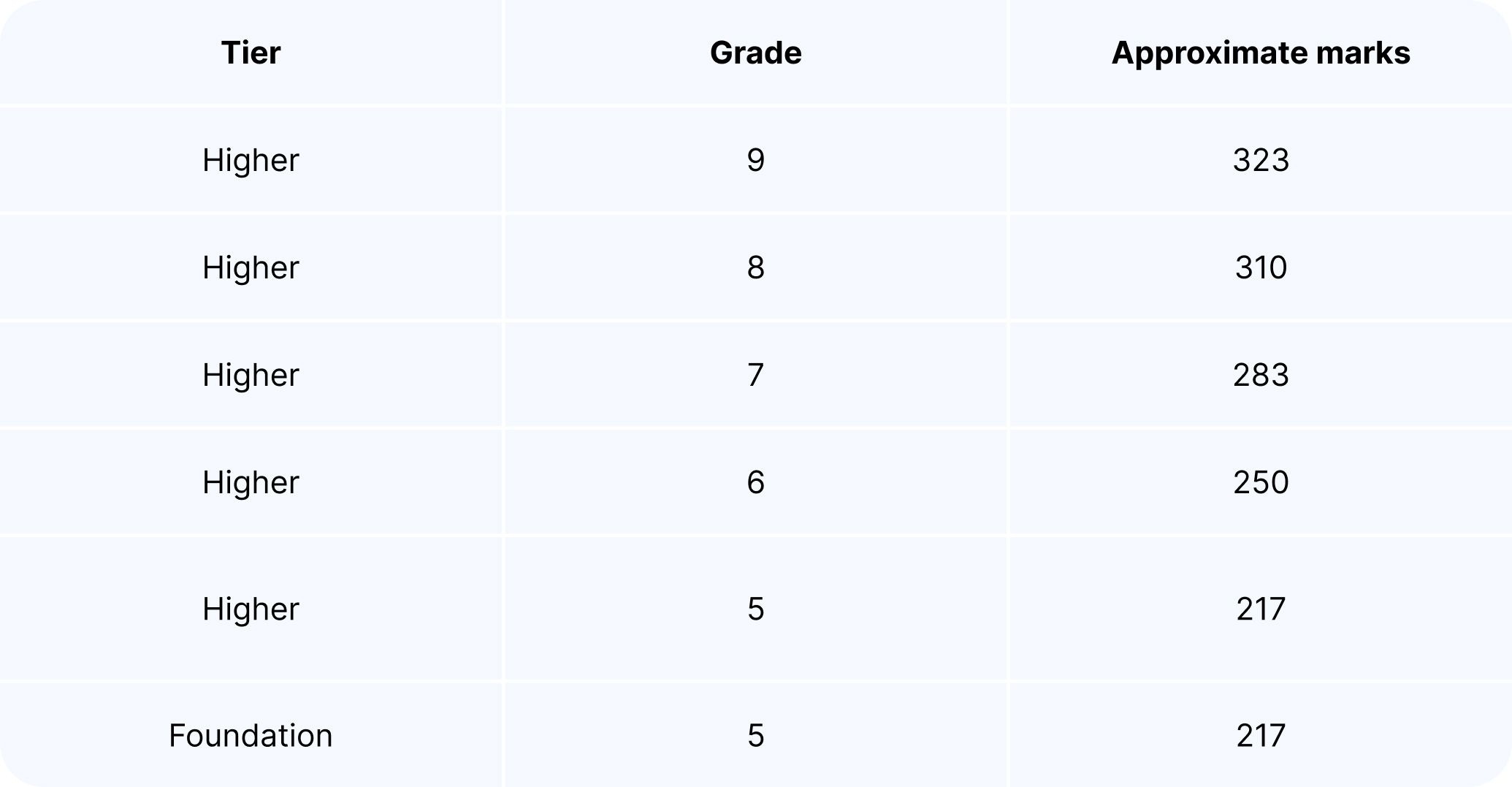Edexcel Combined Science GCSEs: everything you need to know
By Atom | Nov 10, 2025, 11:14 AM
Contents
If you’re taking Edexcel Combined Science GCSE, we’ve got you covered.
This guide takes you through everything you need to know to prepare. Including where to find past papers, potential grade boundaries and what the format of the exam will be. Remember to bookmark this blog for later!
Not sure which exam board your school uses? Take a look at our guide to finding out which exam board you’re studying.
Key takeaways:
Combined Science is a double award, so you’ll receive two final grades.
There are six papers for Combined Science, two for each discipline: Physics, Chemistry and Biology.
A formula sheet for Physics will be provided for Combined Science exams.
What’s the format for Edexcel Combined Science GCSE?
Edexcel Combined Science has the following structure:
Combined Science is a double award, meaning you’ll receive two final grades (eg, 6-7)
There are six papers, two for each of Chemistry, Physics and Biology.
The papers are all 1 hour and 10 minutes long and worth 60 marks each.
The papers are equally weighted with a total of 360 marks available.
You can take the Higher or Foundation tier, but must take the same for all papers.
Free revision timetable template & more
Less stress, more success! Get your free revision timetable templates and guide to effective revision today. Because great revision starts with a solid plan.
What’s the difference between Combined Science: Higher and Foundation?
Edexcel Combined Science is split into Higher and Foundation tiers, depending on your level.
Foundation tier Combined Science Edexcel:
Covers the core topics you need to know and excludes more complex or demanding areas.
In Foundation Combined Science, you can achieve a maximum grade of 5-5.
Higher tier Combined Science Edexcel:
The higher tier covers both core and more advanced topics across the curriculum.
For Higher tier Combined Science, you can achieve a maximum grade of 9-9 - the highest possible grade.
The lowest grade you can get is a 4-4, or a 4-3 for students who just miss a 4-4.
Your school will place you in the correct tier based on your performance in Year 9. Sometimes, students may be moved up or down a tier during Year 10 or 11.
Edexcel requires all Combined Science exams to be taken at the same level, so you cannot do Higher for one part and Foundation for another.
Is there an equations sheet for Combined Science Edexcel?
Yes! It’s been confirmed that equation sheets will continue to be provided for Edexcel Combined Science.
The sheet will cover key formulas used for Physics. The formula sheet includes key equations needed for both the Foundation and Higher tiers.
Take a look at the 2024 equation sheet here.
What are the grade boundaries for Combined Science GCSE?
It’s important to remember that the exact grade boundaries for your GCSE exams will change every year.
Exam boards adjust the grade boundaries after an exam has happened, depending on how advanced the exam content was and how the cohort performed.
This is so students don’t have an advantage or disadvantage because of the year they took the paper. For example, if your paper were harder, grade boundaries would be lowered so that a grade 5 reflects the same level of knowledge as in previous years.
Let’s take a look at the grade boundaries for Edexcel Combined Science from 2024 to get a sense of how grades are awarded:

Remember, these won’t be the exact grade boundaries, but should give you a sense of how many marks to aim for to hit your target grades.
Learn more: take a look at our blog on how GCSE exams are graded.
What grade counts as a pass for Combined Science?
With Combined Science giving you two grades, it can be confusing to understand whether you’ve passed or not if one of your marks is lower than a 4.
So, is a 4-3 a pass for GCSE Combined Science?
It’s important to understand that your grade is based on your overall mark across the three subjects. You can only get either the same grade (5-5) or adjacent grades (5-4), to reflect your performance across the papers.
A 4-3 would not count as a full pass. You have one pass and one fail. The best thing to do is check with your school or college to determine whether you need to resit or not to carry on with your choice of post-16 education.
Where can I find past papers and mark schemes?
Practising with past papers and mark schemes is one of the most effective ways to prepare for GCSE Combined Science.
Past papers help you understand question styles, see how marks are awarded, and build confidence with real exam timing and structure.
Head to the Edexcel website to find past papers and mark schemes from previous GCSE Combined Science exams.
What key topics do I need to know for Edexcel Combined Science GCSE?
Combined Science papers cover a range of topics. You’ll need a thorough understanding of each to achieve top marks, so make sure you revise any areas you find tricky ahead of the exams.
The main topics for Combined Science are:
Biology topics
Cells and control
Genetics
Natural selection and genetic modification
Health, disease and the development of medicines
Plant structures and their functions
Animal coordination, control and homeostasis
Exchange and transport in animals
Ecosystems and material cycles
Chemistry topics
Key concepts in chemistry
States of matter and mixtures
Chemical change
Extracting metals and equilibria
Groups in the periodic table
Rates of reaction and energy changes
Fuels and Earth Science
Physics topics
Key concepts of physics
Motion and forces
Conservation of energy
Waves
Light and the electromagnetic spectrum
Radioactivity
Energy – forces doing work
Forces and their effects
Electricity and circuits
Magnetism and the motor effect
Electromagnetic induction
Particle model
Forces and matter
Check out the Edexcel GCSE Combined Science specification to learn more.
What are examiners looking for?
The assessment objectives for GCSE Combined Science are set by Ofqual, the exams regulator, and are consistent across exam boards.
Examiners are looking for the following in your exam papers:
AO1: Demonstrate knowledge and understanding of scientific ideas; scientific techniques and procedures
AO2: Apply knowledge and understanding of scientific ideas; scientific enquiry, techniques and procedures
AO3: Analyse information and ideas to interpret and evaluate; make judgments and draw conclusions; develop and improve experimental procedures
How can I prepare for Edexcel Combined Science GCSE?
To prepare for Combined Science exams, you’ll need to start revising early to make sure you’re confident covering all the key topics.
5 top tips to prepare for GCSE Combined Science:
1. Understand key vocabulary, definitions and units
Don’t miss out on marks for questions asking you to state or define terms. Make sure you get your head around the key vocab, definitions and units. You can use flashcards to help you memorise key terms and quiz yourself.
2. Use practice papers and mark schemes
The best way to prepare? Practise like it’s test day. Practising exam questions from past papers and checking your answers will help you get used to the question format and understand how to get top marks. You can also take a whole test and practise under timed conditions too, to build confidence for the real thing.
3. Mix up your revision techniques
It’s a good idea to try a mix of revision tactics. From flashcards to teaching others, a mix will help learning to stick. Studying little and often will also help you avoid fatigue and burnout.
4. Practise applying and analysing knowledge and ideas
Assessment objectives 2 and 3 are asking you to apply what you know to analyse and draw conclusions. When you learn a new concept, try asking yourself: how can I apply this in a different scenario? Or what assumptions or errors might affect this conclusion?
5. Plan, review, and adapt your revision
After each mock or practice paper you take, identify the topics or question types you struggle with, then prioritise those in your next revision cycle. Over time, your weak areas will shrink and your confidence will grow!
There you have it - everything you need to know for Edexcel Combined Science. Use this guide to help you plan your revision and make sure you’re thoroughly prepared for your GCSE exams. Good luck!
Don’t miss Atom’s GCSE giveaway!

Six months. Six epic prizes. Six chances to make the GCSE season unforgettable.
We’re launching Atom for GCSE prep in 2026, and to celebrate, over the next six months, we’re giving away thousands of pounds worth of prizes to help your child level up their GCSE revision.
Here’s a taste of what’s up for grabs:
The latest Apple tech, including an iPad Air, Vision Pro and more
Festival tickets for Boardmasters and Reading 2026
Europe interrail passes and £1,000 spending money
…and that’s just a few of the amazing prizes available.
Our first two winners have already taken home incredible prizes! Find out who they are and what they won in our latest giveaway update and keep an eye out for news of our November winner.
It’s free to join. UK only. Full T&Cs apply.
Contents
